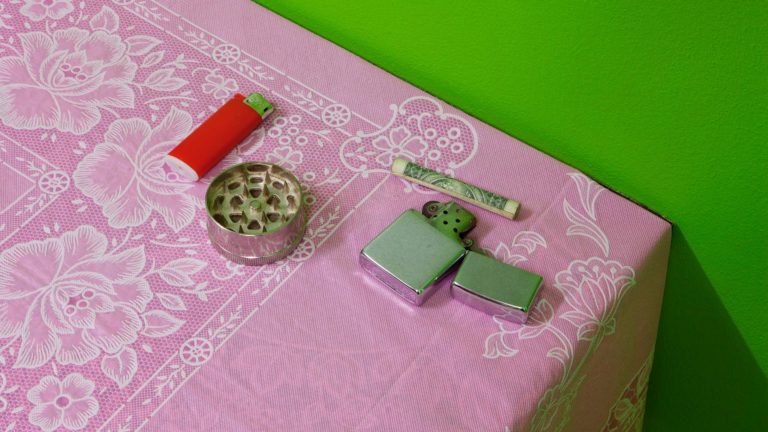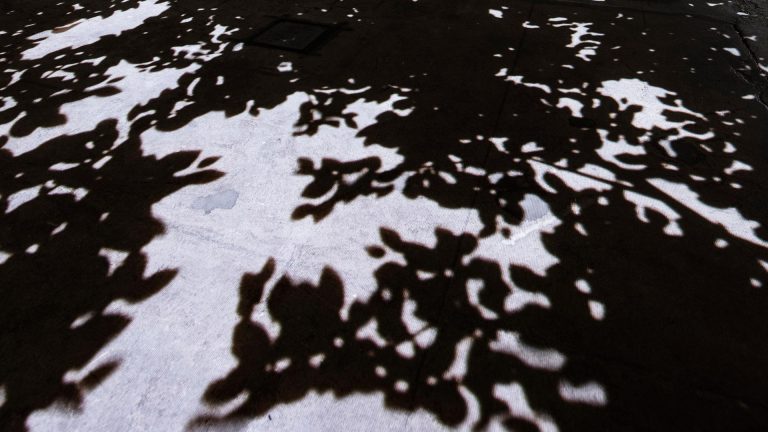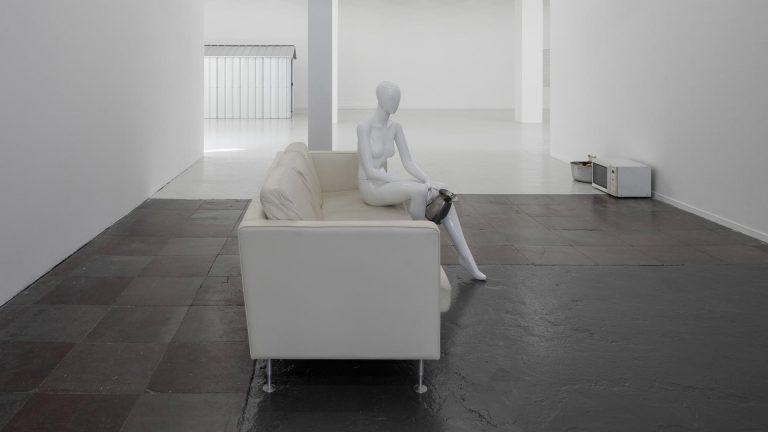Artist: Asbjørn Skou
Exhibition title: Neon Dracula
Venue: Danske Grafikere, Copenhagen, Denmark
Date: January 5 – 30, 2018
Photography: images copyright and courtesy of the artist and Danske Grafikere, Copenhagen
Late capitalist society is haunted by a malicious spectre. It stalks the brightly lit halls of high finance, pulling packs of wolves & ashes from its toxic flesh. This multiform shapeshifting horror consumes & devours and vomits up amputated bodies for work; where the dead employ the living, and humans turn into things. Outside, it’s night in the financial streets, and the claws claws claws are out.
The exhibition is a bastardization of Bram Stokers horror classic, reimagined as a graphic novel in an expanded field, consisting of drawings and woven tapestries. These unfolds a neo-gothic tale of investment banks and real-estate speculation, monsters and surplus value, vampires, capital, and motorized undead labour, digesting the living as a necrotic metabolism.
Political economy of the undead
“His is a metaphysics of inflation”
Towards the end of Volume 1 of Capital, Marx employs one of his usual dramatic and rhetorical devices: ‘If money comes into the world with a congenital blood- stain on one cheek,’ he says, then ‘capital comes dripping from head to toe, from every pore, with blood and dirt’. The comment is a reminder of the extent to which the theme of blood and horror runs through the pages of Capital. Marx claims that ‘capital is dead labour which, vampire-like, lives only by sucking living labour, and lives the more, the more labour it sucks’. He also comments that the prolongation of the working day into the night ‘only slightly quenches the vampire thirst for the living blood of labour’; thus ‘the vampire will not let go “while there remains a single muscle, sinew or drop of blood to be exploited”
Alchemists and hobgoblins, werewolves and dancing tables, the abundance of gothic metaphors in Marx’s writings have not passed unnoticed by past commentators of Capital. Marx’s use of the vampire is merely one of his ‘occult tropes’. We know that Marx enjoyed reading horror stories, and this might explain the existence of a significant gothic thread passing through much of Marx’s writings. But the vampire metaphor is central, in how it might be used to bridge discussions of political economy, subjectivity/subjectification and commodity fetishism.
When Bram Stokers Novel, Dracula, was published in 1897, Marx was already in his restless grave. But with a relation to how Marx first employed the metaphor to describe the property-owning class, it is worth noticing that the initial plot -driver of Dracula is real-estate speculation. A young lawyer, Jonathan Harker, travels to Transylvania to facilitate the sale of ten selected properties in central London. Early in the novel Harker asks his host, the eccentric count, wether “his intention is to raise the market value?”. Dracula’s purpose is of course much more occult than this, but Stokers novel could be re- read as a direct continuation of the use of the vampire metaphor, which is still in employment today; eg. When Journalist Matt Taibi desribes Goldman Sachs as “a great vampire squid wrapped around the face of humanity, relentlessly jamming its blood funnel into anything that smells like money”.
The world of capital is not a world freed from its magical element, it is, even more radically, a world where magic, in the form of fetishism, remains an integral part of the totality of the social relations of production. The movement of capital is a process of enchantment.The process of transition from the feudal to the capitalist mode of production, resolves itself in a transition not from religion to reason, but from religion to magic. The history of capitalism is awash with the awe inspiring mystery and necromancy that surrounds the product of labour and commodities
Capital is a lord; dead labour which rules over the living, which cannot have reason. And it cannot have reason because, capital is nothing else but a “blind and measureless drive,” “insatiable appetite for surplus labour, which oversteps not only the moral but even the merely physical limits” imposed by nature. Vampire-like, capital is condemned to chase endlessly it’s apocalyptic drive shortening the life of labour-power, in the same way as a greedy farmer snatches more produce from the soil by robbing it of its fertility. It is life itself that is destroyed by the necrophiliac unfolding of capital; as famine, misery and the destruction of Nature disappear from sight, capital finally proclaims “the making of profit as the ultimate and the sole purpose of mankind.”
This is the nature of the crisis we live in, this is the omen which the monster of capital screams everyday in our ears.
The boundless drives of the vampire/capital have spun forever out of control. “His action,” as Bram Stoker says of his Dracula, “is based on selfishness, he confines himself to one purpose, and that purpose is remorseless.” That is to say, capital’s egotistical drive for self-valorization offers no space for rational-technical mediation. The magic world cannot be governed anymore, as it used to be in Goethe, within its own categories, simply by the skilful mastery of its own logic. The Hexenmeister is finally hopeless. We are confronted by the necessity to accept the catastrophe or endure a break, a radical discontinuity. The bourgeois class has recalled a force at once subterranean and violent, which now it must faithfully serve. The vampire of Capital rises to unsettle the sanitized categories of bourgeois thought; but the soil on which the monster grows is much more disturbing, much more profound and much more unheimlich than that. The rule of the capitalist over the worker is nothing but the rule of the independent conditions of labour over the worker; the rule of things over man, of dead labour over living.
The commodity is dead labour ; its value is nothing else than accumulated labour, past labour congealed in the commodity form.The world of the fetish, to be clear, is not yet the world of the “strange God of” capital. This is not where the vampire dwells. And yet we may glimpse with unease its shadow if we remember the lesson of anthropology: “a fetish is a god under process of construction.
We must follow the shadow of the commodity-fetish, as it turns and dances within the market, to locate whence its corpse metamorphosed, transformed and took the form of the capitalist monster. the dead body of the commodity not only rises up and dances but it turns towards its own creator to feed itself on his living flesh
It is only the social relation of dominion of the dead over the living that stamps the commodity with the character of capital. Capital does not consist in accumulated labour serving living labour as a means for new production. It consists in living labour serving accumulated labour as the means of preserving and multiplying its exchange value. The monstrous metabolism of the vampire necessitates the subordination of living labour to the power of the dead.
This is a necessary feature of capitalist production since commodities, be they bibles or cargo-ships, cannot produce new value on their own. Commodities, as dead bodies, remain silent, motionless, utterly incapable of (re-)generation. Living labour must seize on these things and change them from merely possible into real and effective use-values; it must awaken them from the dead. The process of production, the expenditure of labour-power, is always a process of value (re-)production. This means that the worker throughout the working day both reproduces past labour objectified in the means of production – that otherwise would decompose and gradually disappear – and adds new value through the expenditure of its own labour-power. So the worker is both a reproducer of past, already-embodied value and a producer of new value, surplus value, equally embodied in the commodity form.
Surplus value, once realized into the market in the form of money, allows the progressive accumulation of capital: The working class creates by the surplus labour of one year the capital destined to employ additional labour in the following year. This is what is called creating capital out of capital. The impersonality of the expropriated worker is here shown in all its internality to the monstrous vampiric metabolism of capital.
The immortality of the vampire is, then, ultimately founded on a constant process of regeneration via living labour. The surplus value extracted by the blood of the workers exits the factory in the form of commodities; then it is realized into the market and takes the form of money; and finally it reappears as capital in the process of production metamorphosed into a surplus of constant capital and variable capital: more machines, more raw material, more workers.
The lesson may be that capital will not die a natural death, Not only will the vampire not age and die in peace; it is rather that the world will not be allowed to age and die in peace confronted by an immortality that can exist only in the form of viral growth. This is the way Stoker’s Dracula cannot die, but must go on age after age adding new victims and multiplying the evils of the world.
Like capital, Dracula is cursed into an eternal striving for new victims, for new fresh blood, bones and muscles to agglomerate into its burgeoning metabolic activity. This is the only way it can live. Dracula travels to London, on his way consuming the very crew aboard the ship that carries him, he purchases properties, seduces humans, visits fine exhibitions, becomes young again. His vampire thirst only slightly quenched by each new acquisition. His victims are either killed, or infested with his ceaseless hunger. The vampire creates a world after its own image.
The first technology utilized by capital in order to squeeze more relative surplus value from the workers, was the simple division of labour. This particular form of cooperation found its maximum expression in the development of the English manufacturing industry in the early 18th century, and yet specialization and parcelling of labour remains a central characteristic of capitalist production, even today. The social division of labour in industry, as any technology caught up within the capitalist mode of production, is not only a means to maximize relative surplus-labour; it also does this by crippling the individual worker, thus producing new conditions for the domination of capital over labour. It converts the worker into a crippled monstrosity by furthering his particular skill as in a forcing-house, through the suppression of a whole world of productive drives and inclinations. Labour, under capital, does not make anyone free.
Technology, under the power of the dead, suffers a true dialectical inversion. Instead of bursting asunder the chains of physical need, freeing up time for the open development of human creativity, it becomes the ultimate instrument serving capital in its drive to ever more efficient means of exploitation. This means that the rule of the dead over the living finally takes a motorized form, as if the vampire in its endless metamorphoses had taken the appearance of a mechanical monster with gigantic members and demonic powers.
Market competition, acts as a spelled mirror continuously reflecting the nature of capital upon the body of the capitalist. Capital is the only true vampire. The capitalist is just as enslaved by the relationship of capitalism as is his opposite pole, the worker, albeit in a quite different manner. This means that the subject in capitalist society can not be the capitalist, and not even the capitalist class; the real subject can only be value, capital, accumulated labour, dead labour.
When seen through the lenses of Marxian analysis, the capitalist is nothing but a human mask behind which the monstrous appearance of capital is kept concealed with all its obscene, excessive drives, with its necrophilia and selfdestructive desire. Behind the human, the vampire. Behind the ascetic protestant ethic of abstinence, the obscene Dionysian drive to consume, devour, spoil all that is life. The social world created by capitalism could then be compared to a spelled carnival in which dwell not men but masks of men. Within the capitalist carnival we find human masks behind which really live monstrous beings. Capitalism, then, reproduces a world where man is really a character-mask, a facade behind which dwell objective economic categories that govern and rule his life. The vampire of capital is the inhuman subject of capitalist society; humans are only its conscious organs.
A long scream of horror. We catch only glimpses of the vampire (sometimes in the mirror, though his reflection should not show there) and that is his true power. The ability of the vampire to conjure up a fog of unknowing around the cause of our collective misery.
To go beyond the gothic realm of the monstrous it will be necessary to overcome the false subjectivities that mirror the capital-vampire. It will be necessary to recognize the inhuman identity that capital has imposed upon us; to become other from ourselves, to realize that under the rule of the dead, we are all Things and not Humans, in a market that makes monsters of us all.
In one sense of course the vampire is a rhetorical literary device. But it is not simply a rhetorical device, in how we can use it to illustrate one of the central dynamics of capitalist production — the distinction between living and dead labour: the desire to create a society founded on the living of full and creative lives rather than one founded on the rule of the dead.
The vampire, as a ‘monster’, is of course connected to the root of that term: from monstrare, meaning ‘to show forth’, monstra, meaning to warn or show, monstrum, meaning ‘that which reveals’, or ‘that which warns. The vampire as monster both demonstrates the capabilities of capital and acts as a warning about it.
This text is comprised from notes, gleaned and stolen from Mark Neocleous, Amedeo Policante, Karl Marx, David Graeber & Bram Stoker.
The exhibition is supported by Statens Kunstfond / The Danish Arts Foundation






































